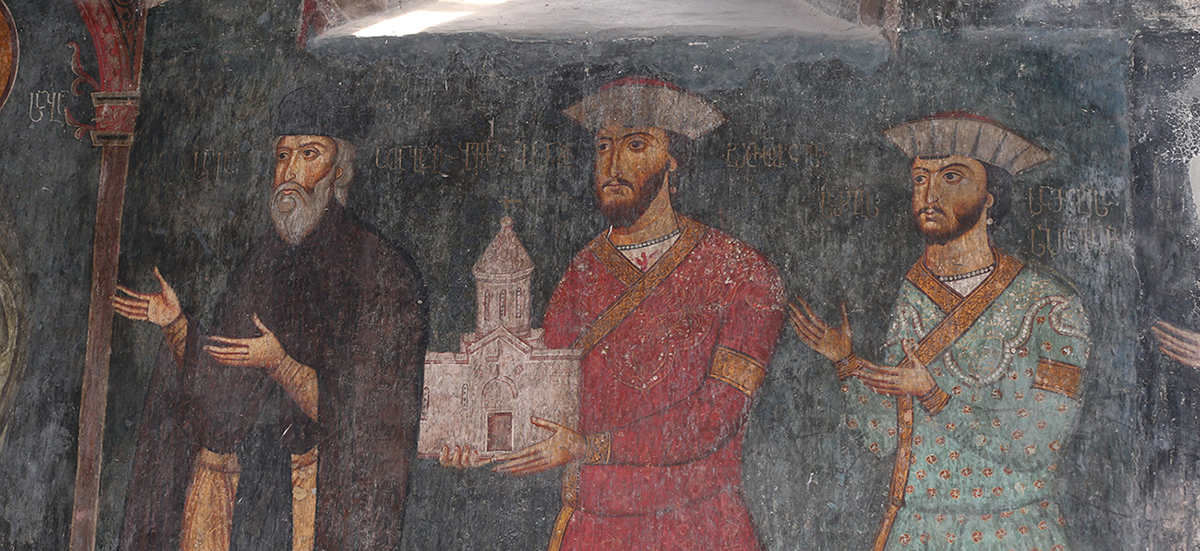
Feel free to add tags, names, dates or anything you are looking for


Sapara Monastery is located ten kilometres from the city of Akhaltsikhe, quite remote from the settlement. The monastery complex is surrounded by richly mountains. During different periods, churches, a fortress, a palace (preserved in ruins), and other buildings were constructed on the terraces of the mountain slopes and merge spectacularly with the terrain.

The monastery in Sapara has existed since the 10th century. The single-nave church of the Dormition of the Virgin belongs to this period. From the second half of the 13th century, Sapara became the residence and burial place of the Jakeli: the Rulers (Atabags) of Samtskhe (a historical region of south-western Georgia).
The main Church of the monastery is the domed church of St. Sabas, to which is adjoined the Dormition church to the south. St. Sabas Church was built and painted in the second half of the 13th century by order of Beka Jakeli, the Ruler (Atabagi) of Samtskhe, which is evidenced by the donor inscription that is preserved here. It was constructed on the site that had previously been occupied by an older church, parts of which are probably included in the building materials of the present church.

Sapara monastery. Church of St. Sabas. Photo: G. Gagoshidze
The Church of St. Sabas was painted in stages: the murals of the dome, the sanctuary apse, and the north and west arms date back to the second half of the 13th century (in certain places an earlier layer of painting can also be discerned); the southern arm was painted at the beginning - of the 14th century. As a result, the murals are not stylistically homogeneous: individual parts reveal affinity with murals of the 12th-13th - centuries, while the painting of the south arm is an example of the Palaeologan style.
The Nativity. Detail.

The Betrayal of Judas. Fragment detail

The Transfiguration. Detail
Sanctuary conch. The Deisis. Photo: Z. Tsertsvadze
All the layers of painting are characterized by more or less bright colouring. The iconographic program is quite extensive. On one hand, it follows the scheme developed in Byzantium, while on the other hand it also displays characteristics of Georgian murals; for example, accommodation of the Deisis in the conch of the apse. The Great Feasts are distributed in the north and south arms, which are enriched with scenes from the Passion cycle.
Dome. The Ascension. Photo: Z. Tsertsvadze
The Last Judgment, two scenes of Christ’s miracles, the Vision of St. Eustathius and the Tree of Jesse are depicted in the west arm.
The Nativity. Photo: N. Kuprashvili
Murals of the South wall. Photo: N. Kuprashvili

The Transfiguration.
The Donor portrait is one of the most impressive images among the wall paintings. It represents three generations of the Jakeli: Sargis I (who was consecrated by the name of Sabas) in monastic garb, his son Beka, and Beka's son- Sargis II. A fourth figure (now severely damaged), who must also have been a member of the Jakeli family was later added to this row. The Jakelis stand in prayer before the Patron Saint of the Church - Saint Sabas. Beka, as a donor, holds a model of St. Sabas church in his hands. The composition is solemn. It occupies the entire lower register of the south wall of the southern arm of the Church. The robes worn by Beka and Sargis II are executed in vivid red and green, and richly decorated with golden ornaments and pearls, - greatly contributing to the festive character of the composition. The portraits are also distinguished by their rather characteristic appearance.

Portraits of Sargis I (Sabas), Beka and Sargis II
Small fragments of paintings from the first half of the 14th century are also preserved in the Church of the Dormition. Beka's three sons - Sargis II, Quarquare and Shalva are depicted here. The images exhibit much in common with the portraits of St. Sabas Church.
Bell tower. The Lasurisdze Portrait.
Beka Jakeli donated the ground floor of the bell-tower at Sapara Monastery to his msakhurtukhutsesi (chief of servants), - Lasur Lasurisdze and his brothers to serve as their funerary chapel. The Lasuridzes commissioned the murals of this small-sized chapel. Their portraits are depicted on the north wall. The level of artistry and workmanship of the chapel wall paintings are much inferior to the St. Sabas Church murals.